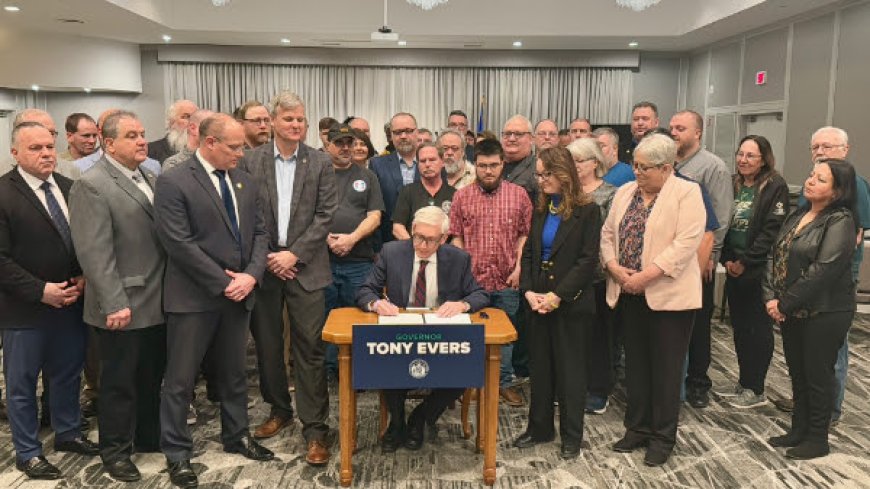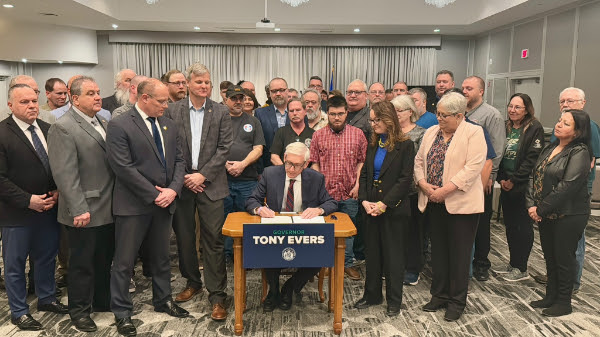Service & Solidarity Spotlight: Wisconsin Gov. Evers Protects Child Labor Law with Senate Bill 436 Veto
Service & Solidarity Spotlight: Wisconsin Gov. Evers Protects Child Labor Law with Senate Bill 436 Veto AFL-CIO

Wisconsin Governor Tony Evers Vetoed Bill Eliminating Work Permit Requirement for Young Workers

Introduction
Wisconsin Governor Tony Evers delivered remarks at the Wisconsin State Council of Machinists’ 2024 spring conference in Madison and vetoed S.B. 436, which would have eliminated the requirement that employers obtain a work permit in order to employ 14- or 15-year-olds.
Sustainable Development Goals (SDGs)
- Goal 8: Decent Work and Economic Growth
- Goal 10: Reduced Inequalities
- Goal 16: Peace, Justice, and Strong Institutions
Importance of Work Permits for Young Workers
The work permit process keeps young workers safer at work through parental oversight and gives critical information about where kids work and what jobs they’re doing to Wisconsin’s Department of Workforce Development, so it can better enforce child labor laws.
Past Legislation and Governor Evers’ Veto
In 2017, then-Governor Scott Walker signed a bill passed by fellow Republicans in the state Legislature that eliminated the work permit requirements for 16- and 17-year-olds. The bill Evers vetoed would have expanded and built on this exemption.
Support for Governor Evers’ Decision
“Governor Evers continues to stand up for the safety of our kids by protecting child labor law in Wisconsin,” said Wisconsin State AFL-CIO President Stephanie Bloomingdale. “The dangerous push to weaken child labor law in Wisconsin and across the country comes at a time when more children are harmed at work or work hazardous jobs.”
“Eliminating these permits would have been a reckless gamble with the well-being of young people,” said Machinists (IAM) International President Brian Bryant in a press release. “Work permits are not merely red tape. They are essential shields protecting our children from exploitation, unsafe conditions, and disrupted education. By vetoing this bill, Gov. Evers has shown clear leadership in prioritizing the safety and welfare of Wisconsin’s future workforce.”
SDGs, Targets, and Indicators in the Article
1. Which SDGs are addressed or connected to the issues highlighted in the article?
- SDG 8: Decent Work and Economic Growth
- SDG 4: Quality Education
The article discusses the issue of work permits for young workers, which is related to decent work and economic growth (SDG 8). It also mentions the importance of protecting children’s safety and welfare, which is connected to quality education (SDG 4).
2. What specific targets under those SDGs can be identified based on the article’s content?
- SDG 8.7: Take immediate and effective measures to eradicate forced labor, end modern slavery and human trafficking, and secure the prohibition and elimination of the worst forms of child labor.
- SDG 4.4: By 2030, substantially increase the number of youth and adults who have relevant skills, including technical and vocational skills, for employment, decent jobs, and entrepreneurship.
The article highlights the importance of work permits in enforcing child labor laws and protecting young workers from exploitation and unsafe conditions. This aligns with SDG 8.7, which aims to eliminate the worst forms of child labor. Additionally, by ensuring that young workers have work permits, it contributes to SDG 4.4 by providing them with relevant skills and opportunities for decent employment.
3. Are there any indicators mentioned or implied in the article that can be used to measure progress towards the identified targets?
Yes, there are indicators mentioned in the article that can be used to measure progress towards the identified targets:
- Number of work permits issued for young workers
- Number of reported cases of child labor violations
- Number of young workers employed in hazardous jobs
The article emphasizes the importance of work permits in ensuring the safety and welfare of young workers. By tracking the number of work permits issued, it can be determined whether there is progress in enforcing child labor laws and eliminating the worst forms of child labor. Additionally, monitoring the number of reported cases of child labor violations and the number of young workers employed in hazardous jobs can provide insights into the effectiveness of measures taken to protect young workers.
SDGs, Targets, and Indicators Table
| SDGs | Targets | Indicators |
|---|---|---|
| SDG 8: Decent Work and Economic Growth | Target 8.7: Take immediate and effective measures to eradicate forced labor, end modern slavery and human trafficking, and secure the prohibition and elimination of the worst forms of child labor. |
|
| SDG 4: Quality Education | Target 4.4: By 2030, substantially increase the number of youth and adults who have relevant skills, including technical and vocational skills, for employment, decent jobs, and entrepreneurship. | N/A |
Behold! This splendid article springs forth from the wellspring of knowledge, shaped by a wondrous proprietary AI technology that delved into a vast ocean of data, illuminating the path towards the Sustainable Development Goals. Remember that all rights are reserved by SDG Investors LLC, empowering us to champion progress together.
Source: aflcio.org

Join us, as fellow seekers of change, on a transformative journey at https://sdgtalks.ai/welcome, where you can become a member and actively contribute to shaping a brighter future.







